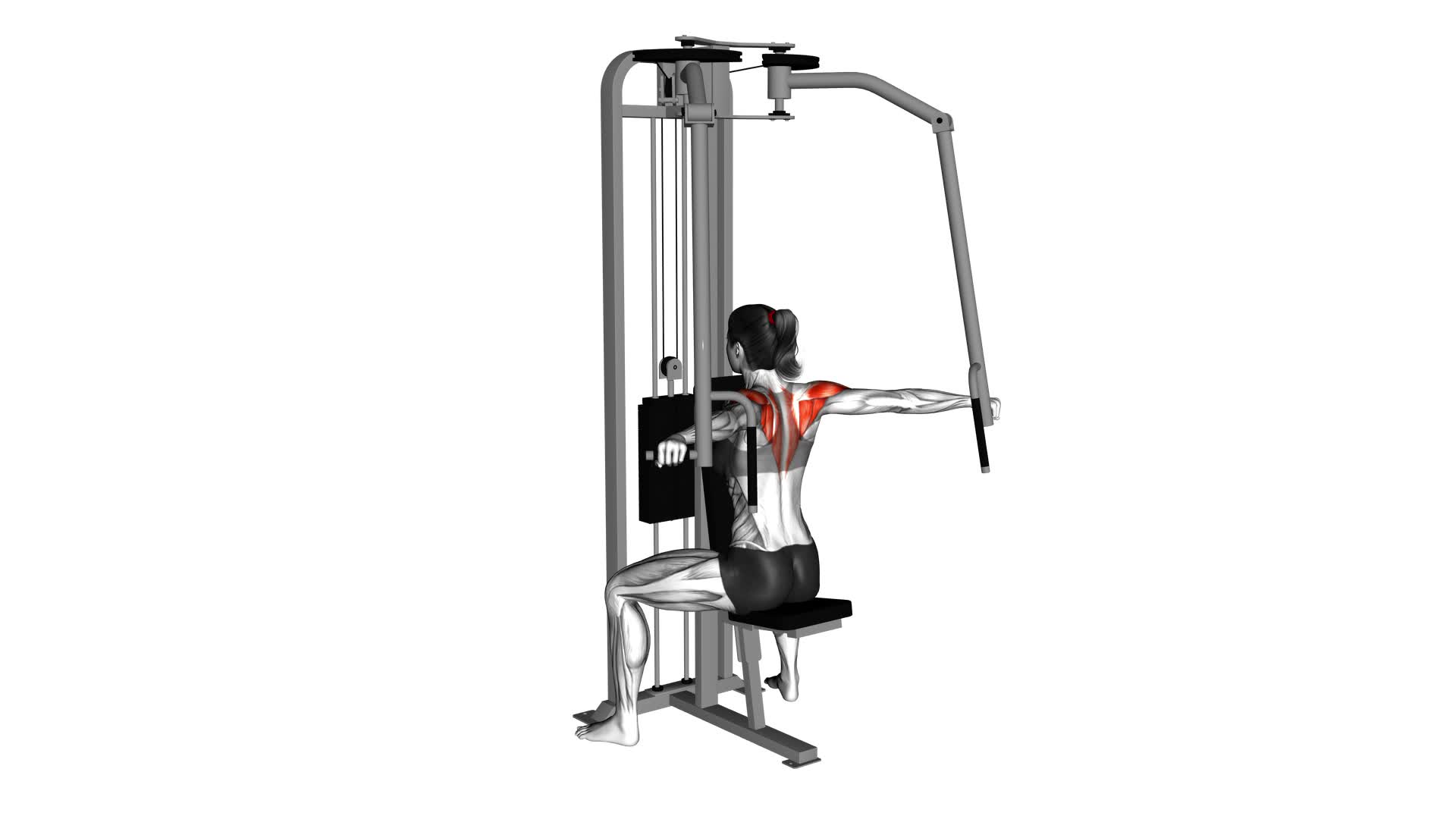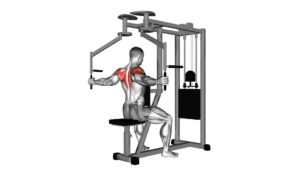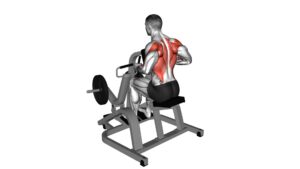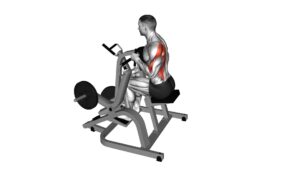Lever Seated Neutral Grip Reverse Fly (Female) – Video Exercise Guide & Tips

Are you looking to strengthen your back and shoulders? Look no further than the lever seated neutral grip reverse fly!
Watch This Exercise Video
This exercise targets those hard-to-reach muscles while improving posture. In this video exercise guide, you'll find step-by-step instructions and helpful tips to ensure proper form and technique.
Don't worry about finding the right weight or making common mistakes – we've got you covered!
Get ready to maximize your results with this effective exercise.
Key Takeaways
- Lever Seated Neutral Grip Reverse Fly is highly effective for maximizing shoulder strength and preventing shoulder injuries.
- It engages muscles in the shoulders, specifically the rear delts, rhomboids, and traps, and strengthens and stabilizes the shoulders.
- Proper form and technique, such as maintaining a straight back, squeezing shoulder blades together, and avoiding swinging or using momentum, are crucial for this exercise.
- It is important to choose the right weight, gradually increase resistance as strength improves, and listen to your body to prevent pain or discomfort.
Benefits of Lever Seated Neutral Grip Reverse Fly
You can experience several benefits from incorporating the Lever Seated Neutral Grip Reverse Fly into your workout routine.
This exercise is highly effective for maximizing shoulder strength and preventing shoulder injuries. By performing this exercise, you engage the muscles in your shoulders, specifically the rear delts, rhomboids, and traps, which helps to strengthen and stabilize these areas.
Strengthening your shoulders is crucial for overall upper body strength and stability, as well as enhancing your performance in other exercises such as overhead presses and bench presses.
Additionally, the Lever Seated Neutral Grip Reverse Fly helps to improve your posture by targeting the muscles responsible for pulling your shoulders back and opening up your chest. This can help alleviate the strain caused by poor posture and reduce the risk of developing shoulder injuries.
Proper Form and Technique
To perform the Lever Seated Neutral Grip Reverse Fly with proper form and technique, it's important to maintain a controlled and consistent motion throughout the exercise. This will ensure that you target the intended muscles and minimize the risk of injury. Here are some tips to help you maintain proper form:
- Keep your back straight: Avoid rounding your back or hunching your shoulders. Maintain a tall posture throughout the movement to engage your upper back muscles effectively.
- Squeeze your shoulder blades: Focus on squeezing your shoulder blades together as you perform the reverse fly. This will activate the muscles in your upper back and help improve your posture.
- Control the weight: Avoid swinging or using momentum to lift the weight. Instead, focus on a slow and controlled motion, allowing your muscles to do the work. This will maximize the effectiveness of the exercise and prevent strain on your joints.
Common mistakes to watch out for and correct include:
- Using too much weight: Start with a weight that allows you to maintain proper form and gradually increase the resistance as you become stronger.
- Rounding the shoulders: Keep your shoulders pulled back and down throughout the exercise to maintain proper alignment.
- Jerking the weight: Avoid any sudden or jerky movements. Maintain a smooth and controlled motion to target the muscles effectively.
Choosing the Right Weight
When choosing the right weight for the lever seated neutral grip reverse fly exercise, it's important to consider a few key points.
First, select a weight that allows you to maintain proper form throughout the movement. This will help you target the intended muscles effectively and reduce the risk of injury.
Additionally, avoid overexerting yourself by choosing a weight that's too heavy. Gradually increase the weight as you become stronger to ensure steady progress in your fitness journey.
Proper Weight Selection
Selecting the appropriate weight for the Lever Seated Neutral Grip Reverse Fly (Female) exercise involves carefully considering your strength level and desired training intensity. Maximizing results and avoiding injuries should be your main priorities when choosing the right weight.
To help you make an informed decision, here are three important factors to consider:
- Start with a lighter weight: It's always better to begin with a weight that feels manageable rather than risking injury by starting too heavy. Gradually increase the weight as you progress and become more comfortable with the exercise.
- Focus on proper form: The weight you choose should allow you to maintain proper form throughout the exercise. If you find yourself struggling to perform the movement correctly, it may be a sign that the weight is too heavy for you.
- Listen to your body: Pay attention to how your body feels during the exercise. If you experience any pain or discomfort, it's a sign that the weight is too heavy and should be reduced.
Avoiding Overexertion
Choose the weight that allows you to maintain proper form and avoid overexertion during the Lever Seated Neutral Grip Reverse Fly (Female) exercise.
It's crucial to prevent injuries by listening to your body and not pushing yourself too hard. Overexertion can lead to muscle strains, sprains, or other more serious injuries.
When selecting the weight, start with a lighter one to ensure you can perform the exercise correctly. Gradually increase the weight as you build strength and confidence.
Pay close attention to your form throughout the exercise, focusing on keeping your back straight and shoulders relaxed. If you feel any pain or discomfort, lower the weight or stop the exercise altogether.
Gradual Weight Progression
To ensure a safe and effective workout, gradually increase the weight for the Lever Seated Neutral Grip Reverse Fly (Female) exercise as you build strength and confidence. Weight progression is an essential aspect of any exercise routine, as it enables you to challenge your muscles and continue making progress.
Here are three key points to keep in mind when progressing the weight for this exercise:
- Start with a comfortable weight: Begin with a weight that allows you to perform the exercise with proper form and technique. This will help you establish a strong foundation and prevent any potential injuries.
- Increase the weight gradually: Once you feel confident and comfortable with the initial weight, gradually increase the load. Aim for a weight that challenges you but still allows you to complete the desired number of repetitions with proper form.
- Listen to your body: Pay attention to how your body responds to the increased weight. If you experience any pain or discomfort, consider reducing the weight or modifying the exercise to better suit your abilities and prevent any potential injuries.
Variations and Modifications
When modifying the Lever Seated Neutral Grip Reverse Fly (Female) exercise, consider incorporating different variations to target specific muscle groups effectively.
Variations and modifications can help add variety to your workout routine and challenge your muscles in new ways.
One variation you can try is using different hand positions. Instead of a neutral grip, you can use an overhand or underhand grip to target different areas of your back and shoulders.
Another variation is to change the angle of the bench or seat. Adjusting the angle can alter the emphasis on different muscles, such as the upper or lower back.
Additionally, you can modify the resistance by using different weights or resistance bands. Increasing or decreasing the resistance can make the exercise more challenging or suitable for your fitness level.
Lastly, you can incorporate unilateral movements by performing the exercise one arm at a time. This can help improve muscle imbalances and enhance overall stability.
Remember to consult with a qualified fitness professional before attempting any new variations or modifications to ensure proper form and technique.
Common Mistakes to Avoid
When performing the lever seated neutral grip reverse fly, proper form is crucial. One common mistake to avoid is using momentum to swing the weights instead of relying on the muscles to control the movement.
Another mistake is hunching the back or rounding the shoulders, which can put strain on the neck and upper back. To correct these form errors, focus on maintaining a stable and controlled movement, keeping the back straight, and engaging the muscles in the upper back and shoulders.
Proper Form Importance
While performing the Lever Seated Neutral Grip Reverse Fly (Female), it's crucial that you maintain proper form to avoid common mistakes. Proper form is essential for several reasons, including the importance of technique and preventing injuries.
Here are three key points to keep in mind:
- Maintain a neutral spine: Ensure that your back is straight throughout the exercise. Avoid rounding or arching your back, as this can strain the muscles and lead to injury.
- Engage your core: Activate your core muscles by pulling your belly button towards your spine. This will provide stability and support to your spine, preventing any unnecessary strain.
- Control the movement: Focus on the controlled movement of your arms. Avoid using momentum or swinging your body to complete the exercise. Instead, use the targeted muscles to perform the movement and maintain control throughout.
Common Mistake Analysis
To identify common mistakes to avoid during the Lever Seated Neutral Grip Reverse Fly (Female), it's important to pay attention to the following key points.
- One common mistake is using too much weight, which can lead to improper form and ineffective results.
- Another mistake is rounding your back during the exercise, which can strain your muscles and increase the risk of injury.
- Additionally, avoid swinging your arms or using momentum to complete the movement, as this takes away from the targeted muscles and reduces the effectiveness of the exercise.
- Finally, keep your shoulders relaxed and avoid shrugging them up towards your ears, as this can cause tension and limit the range of motion.
By being mindful of these common mistakes, you can ensure proper form and maximize the benefits of the Lever Seated Neutral Grip Reverse Fly (Female).
Now let's move on to the next section to learn how to correct these form errors and perform the exercise correctly.
Correcting Form Errors
To correct form errors and avoid common mistakes during the Lever Seated Neutral Grip Reverse Fly (Female), focus on maintaining proper technique throughout the exercise. This won't only help you get the most out of the exercise but also prevent injuries. Here are some key points to keep in mind:
- Keep your back straight and core engaged: Maintaining a neutral spine position is crucial to avoid straining your back and maintain proper form.
- Control the movement: Avoid using momentum or swinging your body during the exercise. Focus on a slow and controlled movement to target the intended muscles effectively.
- Squeeze your shoulder blades: At the peak of the movement, make sure to squeeze your shoulder blades together. This will engage your upper back muscles and maximize the benefits of the exercise.
Tips for Maximizing Results
To maximize your results, focus on maintaining proper form and engaging your shoulder muscles throughout the Lever Seated Neutral Grip Reverse Fly exercise. This will ensure that you're targeting the correct muscles and maximizing the efficiency of your workout.
One way to enhance the effectiveness of this exercise is by incorporating resistance bands into your routine. Resistance bands provide continuous tension throughout the movement, increasing the intensity and challenging your muscles even more.
Start by attaching the resistance bands to the handles of the machine and then take a seat on the bench. Grab the handles with a neutral grip, keeping your palms facing each other. As you perform the reverse fly motion, the resistance bands will provide additional resistance, making your shoulder muscles work harder.
Remember to maintain control and avoid using momentum to swing the weights. Focus on squeezing your shoulder blades together as you raise your arms to the side.
Frequently Asked Questions
How Many Calories Does the Lever Seated Neutral Grip Reverse Fly Exercise Burn?
The lever seated neutral grip reverse fly exercise can help you burn calories and improve your upper body strength. While the exact number of calories burned will depend on factors like your weight and intensity, this exercise is known to be effective for caloric expenditure.
It targets your shoulder and back muscles, helping to tone and strengthen them. If you're a beginner, you can start with lighter weights or resistance bands to make the exercise more manageable.
Can Men Also Perform the Lever Seated Neutral Grip Reverse Fly Exercise?
Yes, men can also perform the lever seated neutral grip reverse fly exercise. It's a great exercise for strengthening the muscles of the upper back and shoulders.
However, if you're looking for alternatives or variations for advanced trainers, you can try the dumbbell or cable reverse fly exercises. These exercises target the same muscle groups and can provide a challenging workout for men looking to improve their upper body strength and posture.
Is This Exercise Suitable for Beginners?
This exercise is great for beginners who want to work on their upper back and shoulder muscles. To modify it for beginners, start with lighter weights and focus on maintaining proper form throughout the movement.
Avoid common mistakes like rounding your back or using momentum to lift the weights. Take it slow and concentrate on squeezing your shoulder blades together as you perform the exercise.
With practice, you'll build strength and improve your posture.
Can the Lever Seated Neutral Grip Reverse Fly Exercise Help Improve Posture?
Yes, the lever seated neutral grip reverse fly exercise can definitely help improve your posture.
By performing this exercise, you'll strengthen the muscles in your back, which play a crucial role in maintaining proper posture.
This exercise specifically targets the rear deltoids and upper back muscles, helping to correct any imbalances and promote a more upright position.
Incorporating this exercise into your routine can be a great way to improve your posture and overall back strength.
How Often Should I Perform the Lever Seated Neutral Grip Reverse Fly Exercise to See Results?
To see results from the lever seated neutral grip reverse fly exercise, you need to perform it with the right frequency. The optimal duration for this exercise varies depending on your fitness goals and current fitness level.
However, it's generally recommended to perform this exercise at least 2-3 times per week. Consistency is key, so make sure to stick to a regular routine and gradually increase the intensity as you progress.
Conclusion
To conclude, the lever seated neutral grip reverse fly is a highly effective exercise for targeting the muscles of the upper back and shoulders.
By maintaining proper form and technique, choosing the right weight, and avoiding common mistakes, you can maximize the benefits of this exercise.
With variations and modifications available, you can tailor the exercise to your fitness level and goals.
By following these tips, you'll be on your way to achieving great results and improving your upper body strength.

Author
Years ago, the spark of my life’s passion ignited in my mind the moment I stepped into the local gym for the first time. The inaugural bead of perspiration, the initial endeavor, the very first surge of endorphins, and a sense of pride that washed over me post-workout marked the beginning of my deep-seated interest in strength sports, fitness, and sports nutrition. This very curiosity blossomed rapidly into a profound fascination, propelling me to earn a Master’s degree in Physical Education from the Academy of Physical Education in Krakow, followed by a Sports Manager diploma from the Jagiellonian University. My journey of growth led me to gain more specialized qualifications, such as being a certified personal trainer with a focus on sports dietetics, a lifeguard, and an instructor for wellness and corrective gymnastics. Theoretical knowledge paired seamlessly with practical experience, reinforcing my belief that the transformation of individuals under my guidance was also a reflection of my personal growth. This belief holds true even today. Each day, I strive to push the boundaries and explore new realms. These realms gently elevate me to greater heights. The unique combination of passion for my field and the continuous quest for growth fuels my drive to break new ground.







